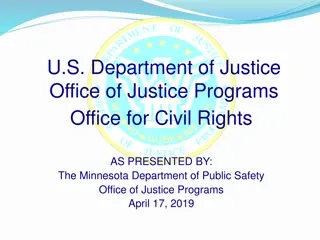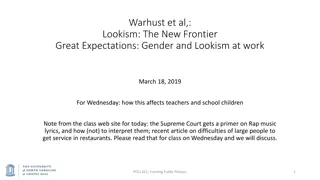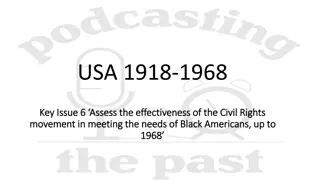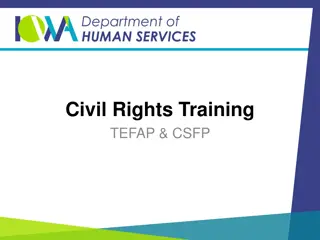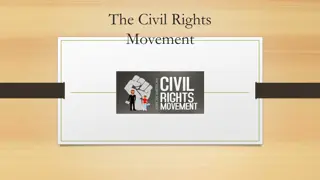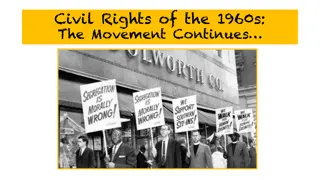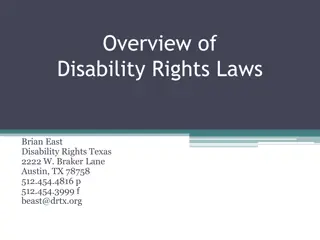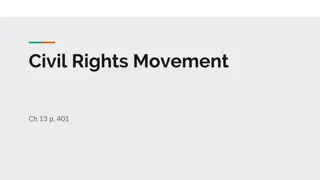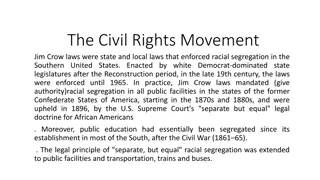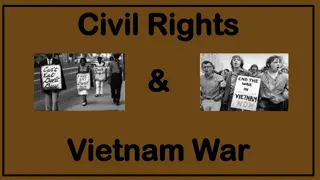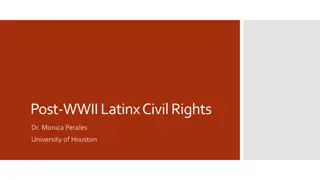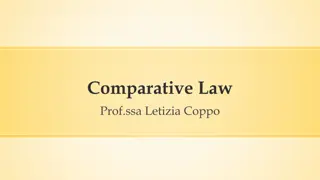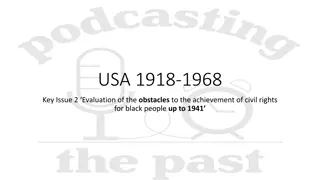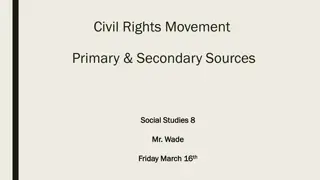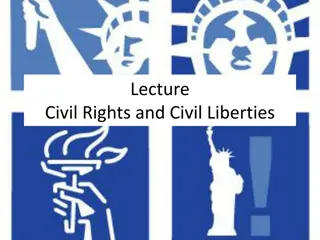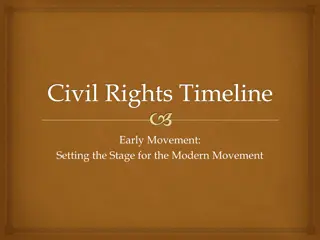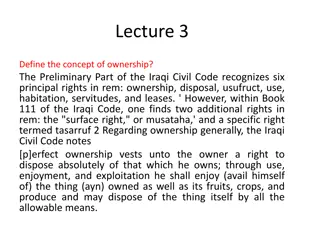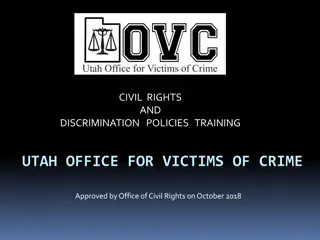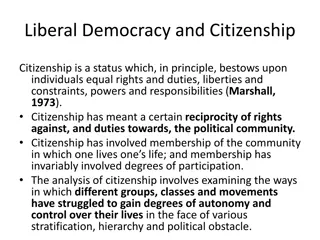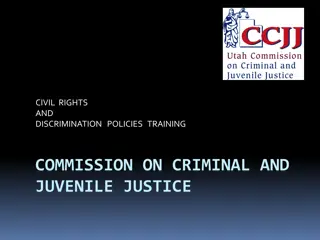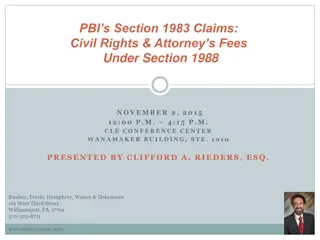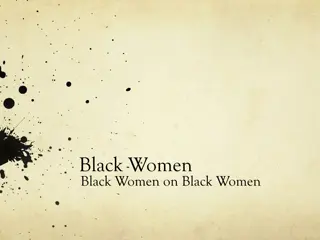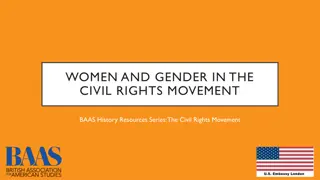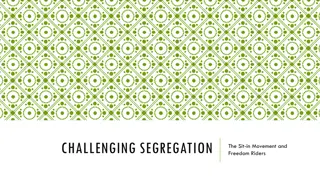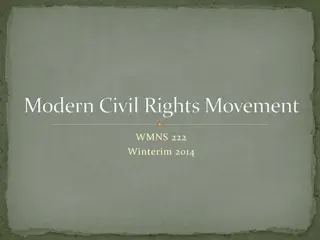Overview of Civil Rights Movement and Key Federal Laws
The Civil Rights Movement of the 1950s and 1960s aimed to secure rights for African Americans through civil disobedience, leading to landmark events like Rosa Parks' protest and Martin Luther King Jr.'s iconic speeches. Federal laws, such as the Civil Rights Acts of 1957, 1960, 1964, and 1968, were passed to combat discrimination based on race, color, national origin, and gender. These laws also extended to protect the rights of women and Hispanics, paving the way for greater equality and justice.
Download Presentation

Please find below an Image/Link to download the presentation.
The content on the website is provided AS IS for your information and personal use only. It may not be sold, licensed, or shared on other websites without obtaining consent from the author. Download presentation by click this link. If you encounter any issues during the download, it is possible that the publisher has removed the file from their server.
E N D
Presentation Transcript
Chapter 11: Civil Rights Section 3: Civil Rights Laws (pgs.334-340)
The Civil Rights Movement This was a mass movement in the 1950s and the 1960s to guarantee the Civil Rights of African Americans. These protesters used Civil Disobedience to get rid of the Jim Crow Laws. The 1stkey event in this movement was when Rosa Parks refused to give up her seat in Montgomery, Alabama. MLK Jr. was brought in to lead this Bus Boycott. In 1963, he gave his I have a dream speech in front of 200,000 people in D.C. The 1965, march from Selma to Montgomery brought about Bloody Sunday and led to the passage of new federal civil rights laws. https://s-media-cache-ak0.pinimg.com/736x/73/18/9d/73189dc73e7da8a73d397dfe10bc4122.jpg
New Federal Laws In response to the civil rights movement, Congress passed a series of federal laws to try to protect all Americans. The Civil Rights Act of 1957- this set-up a Commission to investigate civil rights violations and also had the Justice Department enforce civil rights laws. The Civil Rights Act of 1960- gave the federal government the power to inspect local voter registration rolls and penalize anyone who obstructs a person s right to vote. https://upload.wikimedia.org/wikipedia/commons/d/d9/Eisenhower_in_the_Oval_Office.jpg
More New Federal Laws 24thAmendment- Banned the use of poll taxes in federal elections. Civil Rights Act of 1964- Banned discrimination based on race, color national origin, or sex in voting, employment, and public accommodations. Voting Rights Act of 1965- banned unfair tests in voting, such as literacy tests and allowed federal agents to help register blacks. Civil Rights Act of 1968- banned discrimination in the sale, rental, or financing of housing. http://rollingout.com/wp-content/uploads/2014/07/MLK-and-Johnson.jpg?a5de54
Extending Civil Rights- Women The African Americans progress inspired other groups who were also victims of discrimination. The Equal Pay Act of 1963 required employers to offer equal pay to women and men. The Civil Rights Acts of 1964 & 1968 both helps women as well as minorities. The Equal Credit Opportunity Act of 1975- prohibited banks, stores, & other businesses from discriminating against women in loans & granting credit. The courts have also helped women expand their rights. The Supreme Court ruled in Roe v. Wade in 1973 on abortion & in 1986 they ruled against sexual harassment. http://img.timeinc.net/time/photoessays/2010/top10_court_cases/roe_wade.jpg
Extending Civil Rights- Hispanics In 1946, the federal court ruled that the state s segregation of Hispanic students was illegal. In 1954, the federal court ruled that the equal protection clause applied not only to blacks but also Hispanics & other racial groups. In 1975 the Voting Rights Act was expanded to require that ballots be printed in Spanish and other languages in different communities. Cesar Chavez helped to extend civil rights for Hispanics through Civil Disobedience-- marches and hunger strikes. http://www.quoteslides.com/large/Slide108.JPG
Extending Civil Rights- Native Americans Indians http://liberationschool.org/wp-content/uploads/2014/08/AIM.jpg The American Indian Movement (AIM) used aggressive and symbolic protests to call attention to their inferior status. In 1972, AIM took over the Bureau of Indian Affairs building in D.C., & demanded a review of all treaty violations, more education &economic help. Congress passed the Indian Self- Determination and Education Assistance Act in 1975. In 1978, Congress passed the American Indian Religious Freedom act, which stated that they had the same religious freedom that other Americans had.
Extending Civil Rights- People with Disabilities In 1990, Congress passed the American with Disabilities Act. This prohibited discrimination against people with disabilities & also required public buildings and transportation facilities. Now public buildings have ramps & elevators. In 2003, a federal case led to improved conditions for patients in state run psychiatric facilities. https://www.aclusandiego.org/wp-content/uploads/2008/01/ADA-Sign.png
Affirmative Action Today, discrimination is illegal But is that enough? Women and minorities are still underrepresented in many jobs. Affirmative Action is a policy that requires employers and institutions to provide opportunities for members of certain historically underrepresented groups. Supporters believe government should actively promote equality for members of racial and ethic groups and women. Opponents argue that such efforts lead to special privileges for minorities and it is unfair to whites or reverse discrimination. http://www.truthdig.com/images/made/images/cartoonuploads/affirmative_590_396.jpg
Affirmative Action Cases In a 1978 case the Supreme court ruled race can be used as one factor in college admissions, but quota systems are unconstitutional. In the 1987 case the Court ruled consideration of sex as a factor in promotions is acceptable. In the 1995 case the Court ruled that Affirmative Action must be targeted at specific problems of past discrimination. In the 2003 case the Court reaffirmed that race can be used as one factor in admissions, but overturned a system that awarded points to minorities. CA, WA, and MI all voted on Affirmative Action and they banned it accepted in cases dealing with the Federal Government. https://www.tjhsst.edu/~sgoswami/images/justices/fullcourt.gif





